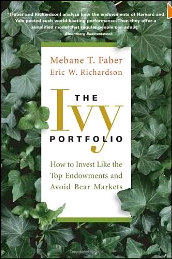 For a couple of years now, I have been charting the Ivy ETF Portfolio to see how well it would work within the rules of trend tracking.
For a couple of years now, I have been charting the Ivy ETF Portfolio to see how well it would work within the rules of trend tracking.
If you are not familiar with “The Ivy Portfolio,” you can buy the book at Amazon. It shows step-by-step how to track and mimic the investment strategies of the highly successful Harvard and Yale endowments.
Using the endowment policy portfolios as a guide, the authors illustrate how an investor can develop a strategic asset allocation using an ETF-based investment approach.
More importantly, the book reveals a novel method for investors to reduce their risk through a tactical asset allocation to protect them from bear markets. Translated that simply means they are using a trend tracking approach to only remain invested during bull markets, while moving to the sidelines during bear markets.
It is trend tracking at its finest, but there are two major differences to the approach I have been advocating for over 20 years:
1. The author’s preference is the use of a 45-day moving average as a directional indicator, where I use 39 weeks.
2. No sell stops are being used, and only the crossing of the respective trend lines serves as an entry and exit point. While that is workable, I need to point out that in case of a trend reversal, you will be giving up a larger amount of profits before your sell signal kicks in then if you had used trailing sell stops.
On the other hand, you will not experience the type of whipsaw signals we had to live with last year. There is simply no perfect approach to solve all investment problems, but at least the biggest concern for many investors is a solid part of this methodology: Stay away from bear markets.
The idea is to only allocate your portfolio into 5 different asset classes and only when each asset class has broken above its own long-term trend line. That is exactly how I treat sector and country allocations.
Whether you use a 39-week or 45-week moving average, or work with sell stops or trend line breaks to determine whether to be in or out of the market is immaterial. What matters is that you use an approach that avoids the bear market trap. Trend Tracking will do that for you and so will the rules of the “The Ivy Portfolio.”
Starting with next Wednesday’s portfolio update, I have added the “Ivy ETF Portfolio” to my tracking sheet as portfolio #6. I consider it a worthy addition, especially with its simple 20% allocation to only 5 different asset classes. Stay tuned!
Contact Ulli
Comments 4
I’ve been using the Ivy Portfolio for about a year, and like it’s simplicity, much as I like yours. However, one difference that I’ve noted is that Faber checks his ETFs only once a month for possible action, whereas you keep an eye on your holdings daily, if I understand your methodology correctly. Do you have any comments on which is most sensible? It would seem that your method would keep you more on top of fast changing prices. On the plus side for the Ivy, it would avoid more whipsaws, but might put you more underwater before you make a move. Comments?
That is exactly what I said in the post. Not using trailing sell stops will expose to giving back too much in profits when the inevitable directional turnaround occurs. Personally, I prefer playing it a little safer by using sell stops in order to at all times limit my risk.
Ulli…
Thanks for adding the Ivy Portfolio. Do you use your 7% mutual fund sell stops or the 10% ETF stops that you have written about. I saw a recent post on ETFs that referred to the 7% version which is why I ask.
Thanks for your great service in bringing this to regular folks. I started investigating the Ivy Portfolio approach last year and find it extremely workable. I am also looking at the Ivy 10 version from the book.
Paul,
Here are my trailing sell stop rules again: For broadly diversified domestic and international ETFs/mutual funds, I use 7%. For more volatile sector/country ETFs/funds, I use 10%. Both are being applied on a close only basis.
Ulli…